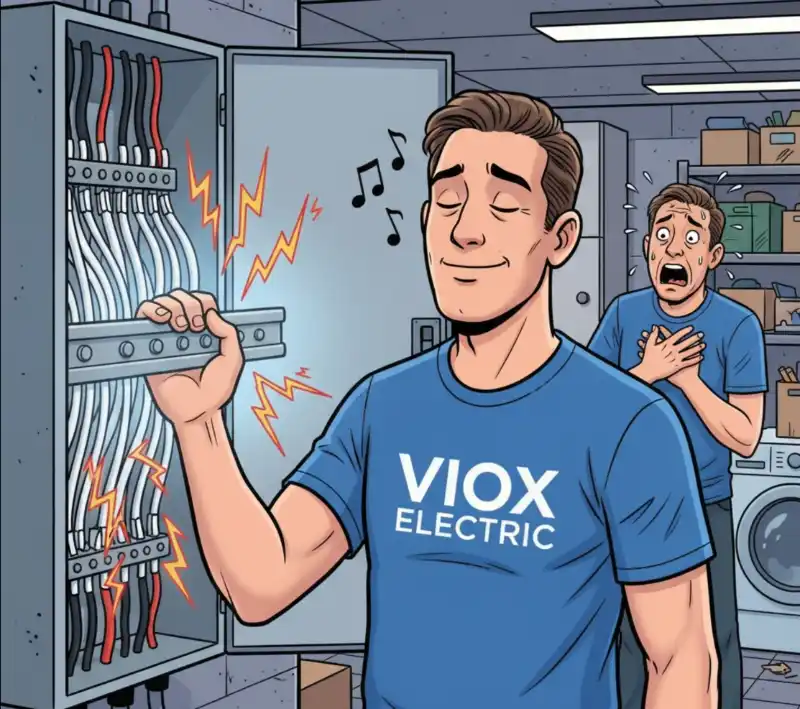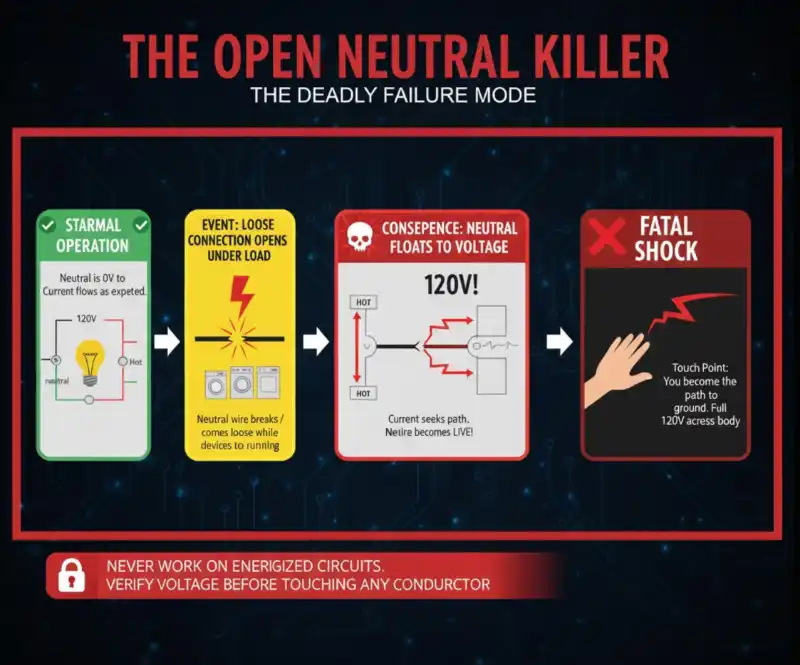
You’re standing in your basement watching your electrician work. The main panel is open—live, energized, 200 amps of potential death just inches away. He reaches in with his bare hand and grabs the neutral bus bar. Your heart stops. But he doesn’t even flinch. Ten seconds later, he’s torquing down terminal screws on that same bar, skin contact the whole time, humming along like he’s changing a light bulb.
So what’s happening here? If the neutral conductor carries current back from your lights, appliances, and motors to complete the circuit, why isn’t that bus bar electrifying anyone who touches it? And more importantly—when does it become deadly?
The answer involves some counterintuitive physics, a dangerous myth that’s been repeated so often it’s become “common knowledge,” and a critical bonding requirement that stands between routine maintenance and a fatal shock. Let’s start with why touching a live neutral bar usually won’t kill you.
The Zero-Volt Zone: Why You Can Touch a Live Neutral Bar
Here’s the thing that makes your panel’s neutral bar safe to touch: it’s electrically connected to the same ground you’re standing on. Literally. At your service entrance—where power enters your home—the neutral conductor is bonded (connected) to the grounding electrode system. That grounding system connects to earth through ground rods, metal water pipes, or a concrete-encased electrode. You’re standing on that same earth.
This creates what we’ll call “The Zero-Volt Zone”—an equipotential plane where the neutral bar, the ground bar (which is bonded to it), the metal panel enclosure, and the earth beneath your feet are all at the same electrical potential. No voltage difference means no current flow.
Think of electrical potential like elevation. If you’re standing on a flat surface—a perfectly level floor—there’s no “downhill” for you to fall toward. Water doesn’t flow, objects don’t roll, and you don’t tumble over. Voltage works the same way: current only flows when there’s a difference in electrical potential between two points, just like water only flows when there’s a difference in elevation.
When you touch the neutral bar with one hand while standing on the concrete floor, both points of contact (your hand and your feet) are at the same potential—zero volts relative to earth. No downhill slope, no current flow, no shock. The electrician’s casual confidence isn’t bravado—it’s physics.
Pro-Tip #1: The neutral bus bar is safe to touch because it’s bonded to ground at the service entrance—creating zero potential difference between you, the bar, and the earth beneath your feet. This bonding occurs at ONE point only (the service disconnect), never at subpanels, as per NEC Article 250.24(A)(5) and IEC 60364-5-54.
But here’s where it gets interesting: there is current flowing through that neutral bar. Sometimes significant current—15 amps, 30 amps, even 50+ amps on a main panel’s neutral bus. So why doesn’t even a tiny fraction of it go through your body? That brings us to the most dangerous myth in electrical work.
Why “Path of Least Resistance” Gets Electricians Killed
You’ve heard it a thousand times: “Electricity takes the path of least resistance.” It’s repeated in forums, YouTube videos, and unfortunately, by electricians who should know better. This is what gets taught in every trade school and remembered by almost nobody who graduates. Here’s the problem: it’s completely wrong.
Well, not completely. It’s technically true in the sense that a river “takes the path of least resistance” downhill—but just like a river, electricity doesn’t limit itself to just ONE path. Electricity takes ALL available paths back to its source, dividing current across each path in proportion to that path’s conductance (the inverse of resistance). This is Kirchhoff’s Current Law, and it’s been validated physics since 1845.
Let’s put numbers to this, because that’s where the “path of least resistance” myth collapses. Imagine you’re touching a neutral bus bar that’s carrying 20 amps back to the service entrance through a 10 AWG copper wire. The resistance of that 10 AWG neutral conductor over 50 feet is approximately 0.05 ohms. Your body resistance, hand-to-feet through dry skin? Between 1,000 and 100,000 ohms, depending on how sweaty your hands are and how good your boots are. Let’s be conservative and say 10,000 ohms.
Now here’s the critical insight: current divides inversely proportional to resistance. That 10 AWG wire has 1/200,000th the resistance of your body (0.05Ω vs 10,000Ω), so the wire carries 200,000 times more current than your body does. If 20 amps is flowing through the neutral, your body gets about 0.0001 amps—or 0.1 milliamps. That’s one ten-thousandth of the current. You won’t feel it. The wire gets 19.9999 amps, you get 0.0001 amps. Both paths carry current, but the difference is so extreme that you perceive your path as carrying “none.”
Pro-Tip #2: Electricity doesn’t “choose” the wire over you—it takes ALL paths proportionally. You don’t get shocked because your body’s resistance is so high that your share of the current is measured in microamps, not the dangerous milliamps that cause ventricular fibrillation (30-50mA through the chest).
This is why the “path of least resistance” myth is so dangerous: it makes people think that if there’s a low-resistance path available, they’re completely safe. They’re not safe—they’re safer, which is very different. If you complete a circuit across your chest with wet hands on a faulty piece of equipment, even with a “better” path available through ground, enough current can flow through your heart to stop it. The myth kills because it makes people casual.
The Voltage Drop Ghost: Why There’s Voltage (But You Don’t Feel It)
Now let’s address something the technical discussion revealed: there actually IS a small voltage difference along that neutral bus bar when current is flowing. We’ll call this “The Voltage Drop Ghost”—it’s there, measurable with a good multimeter, but it can’t hurt you under normal conditions.
Here’s why it exists: all conductors have resistance, even copper bus bars and heavy-gauge wire. When current flows through resistance, voltage drops. Let’s calculate it for a real scenario.
Imagine a 100-foot run of 12 AWG copper neutral wire carrying 15 amps back to the panel from a loaded circuit (ten 100-watt incandescent bulbs, for instance). The resistance of 12 AWG copper at 75°C is approximately 2.01 ohms per 1,000 feet, or 0.201 ohms per 100 feet. Using Ohm’s Law (V = I × R): V = 15A × 0.201Ω = 3.02 volts. That’s the total voltage drop over the entire 100-foot neutral run.
Now, focus on just the 3 feet of neutral wire inside the panel, from where it enters to where it terminates on the bus bar. The voltage drop across those 3 feet? 3 feet / 100 feet × 3.02V = 0.09 volts. If you touched the neutral wire where it enters the panel with one hand, and the neutral bus bar with your other hand, there’s a 0.09-volt difference between your hands. That’s 90 millivolts.
To put this in perspective: a AA battery is 1.5 volts—about 17 times more voltage than this. Can you feel a AA battery on your dry skin? No. Neither can you feel 0.09 volts. Your skin acts as an insulator with a sensation threshold of approximately 30-50 volts for dry skin (much lower if wet—down to 10-20 volts with sweaty hands). Below that threshold, almost no current penetrates your skin’s outer layer.
If you had a sensitive enough voltmeter and steady enough hands, you could map the voltage gradient across that bus bar like a topographic map. But even the highest “peak” wouldn’t be enough to feel. This is why the Voltage Drop Ghost haunts your neutral bar but doesn’t hurt you.
Pro-Tip #3: There IS voltage on that neutral bar—typically 0.02-0.10V per foot of wire under load—but it’s far below the 30-50V needed to overcome your dry skin’s resistance. This is also why Ground Fault Circuit Interrupters (GFCIs) don’t trip from normal neutral voltage drop; they’re monitoring imbalance current (greater than 5mA), not voltage.
So far, everything sounds pretty safe, right? The neutral bar is bonded to ground, creating a zero-volt zone. Your body’s high resistance means almost no current goes through you. The tiny voltage drop that exists is harmless. But now it’s time to meet the scenarios that kill people.
The Open Neutral Killer: When That “Safe” Wire Becomes Deadly
Here’s what separates routine electrical work from fatal accidents: context. Touch a neutral bar in a properly bonded panel while standing on a concrete floor? Safe. Touch a neutral wire that’s opened upstream under load? You’re dead. Let me show you when The Open Neutral Killer strikes.
Scenario 1: The Loose Connection Under Load
Your washing machine, dryer, and electric water heater are all running—pulling, let’s say, 35 amps combined through their shared neutral return path. Somewhere upstream—maybe at a junction box, maybe at a breaker terminal, maybe at the panel neutral bar itself—a connection is loose. It’s been loose for months, slowly heating up, oxidizing, increasing its resistance. One day, that connection opens under load. The circuit is broken.
But here’s the critical part: the neutral conductor on the load side of that break is now at full line voltage. Why? Because current is trying to flow from the hot side of your appliances, through their loads, and down to where the neutral should connect—but it can’t get there. The appliances become voltage dividers, and the neutral wire floats to approximately 120V (in a 120V circuit) or 230V (in a European 230V circuit) relative to ground.
Touch that “neutral” wire now? You become the path to ground. Full current flows through your body. This is how experienced electricians get killed doing “routine” work. They disconnect a neutral wire to reroute it, not realizing there’s a load on the circuit, and the instant they touch the bare wire, 120V drives current through their body to ground.
Pro-Tip #4: Never disconnect a neutral conductor while circuits are energized, even if you’ve turned off the breaker. Multi-wire branch circuits (MWBC) can backfeed voltage through the neutral if only one breaker is off, creating a deadly scenario where the “dead” neutral wire is actually at 120V relative to ground.
Scenario 2: The Multi-Wire Branch Circuit Trap
Speaking of MWBCs, here’s a specific failure mode that kills both DIYers and professionals. A multi-wire branch circuit uses one shared neutral to serve two 120V hot conductors on opposite phases. Under balanced load, the neutral carries only the difference between the two hot loads. But here’s what happens when you open that shared neutral at the panel:
Circuit 1 is feeding your living room lights (200W, about 1.7A). Circuit 2 is feeding your window AC unit (1,500W, about 12.5A). You flip both breakers off. The circuits are “dead,” right? Wrong. You disconnect the neutral wire from the bus bar to relocate it. The instant that neutral opens, the two circuits become series-connected across 240V (in North American split-phase systems).
Your 200W of lights are now in series with 1,500W of AC load across 240V. The voltage divides proportionally to the loads’ impedances. The lights see about 28V. The neutral wire—the one you’re holding—is now at 212V relative to ground. Your voltage tester reads zero on both hot wires. You’re confident. You’re wrong. Touch it? Game over.
This scenario has killed multiple electricians who thought they were working on “dead” wires because they’d turned off the breakers.
Scenario 3: Lost Neutral at the Service Entrance
The nightmare scenario: the utility neutral connection at your service entrance fails. This can happen from corrosion, physical damage, or a poorly made connection at the weather head. When the main neutral opens while loads are operating, all your 120V circuits become series-connected across 240V. Lights on one phase see overvoltage and explode. Electronics on the other phase see undervoltage and die. And every neutral conductor in your home jumps to some fraction of 240V, depending on load balance and phase configuration.
Touch any neutral wire—any “ground” wire, any metal appliance frame—and you’re completing a 240V circuit to earth through your body. That single connection at the service entrance? It’s absolutely non-negotiable.
Why Neutral-Ground Bonding Is Non-Negotiable
Everything we’ve discussed—The Zero-Volt Zone, the equipotential plane, the reason you don’t get shocked touching a properly bonded neutral bar—hinges on one critical connection: the neutral-ground bond at the service entrance. This isn’t a suggestion. It’s not “best practice.” It’s a code requirement with the force of law behind it.
NEC Article 250.24(A)(5) (2023 edition) requires that “the neutral conductor shall be grounded” at the service disconnect, and only at the service disconnect. Internationally, IEC 60364-5-54 establishes the same principle: one main grounding point, typically at the origin of the installation.
Here’s why this single-point bonding matters: (1) It establishes the reference potential for your entire electrical system. Without it, “neutral” and “ground” float relative to each other, and the voltage difference can become lethal. (2) It ensures fault current has a low-impedance path back to the source. When a hot wire contacts a grounded metal enclosure, the resulting fault current must be high enough to trip the breaker quickly—ideally within 0.1 seconds. That requires a solid ground connection. (3) It prevents overvoltage conditions during neutral loss. If the utility neutral opens and your ground system isn’t bonded, your entire home can float to dangerous voltages. (4) It provides a safe zero-reference for human contact. The neutral bar, the ground bar, the panel enclosure, and earth all become equipotential—creating the Zero-Volt Zone we discussed earlier.
What happens if you bond neutral and ground at a subpanel, violating the “one bond only” rule? You create parallel ground paths, which means neutral current starts flowing through your grounding conductors and metal raceways. Those paths weren’t designed to carry continuous current. They heat up. Connections corrode. And suddenly, the “ground” wire that’s supposed to protect you is carrying enough current to shock you when you touch a metal appliance frame. One bond is a circuit diagram. Two bonds is a lawsuit waiting to happen.
This is why NEC 250.142(B) explicitly prohibits grounding the neutral at any point downstream of the service disconnect. One bond. At the service entrance. Nowhere else.
Pro-Tip #5 (Critical Safety): The neutral-ground bond must exist at exactly ONE point: the service disconnect or main panel. Never bond neutral to ground at subpanels (250.32 exception), never at appliances, never at junction boxes. This single-point bonding ensures fault current flows correctly and prevents neutral current from traveling through ground paths.
The Bottom Line: When “Safe” Becomes “Deadly”
So here’s what we’ve learned about when neutral bus bars are safe versus deadly:
The neutral bus bar won’t kill you when: It’s properly bonded to ground at the service entrance; you’re standing on a grounded surface (concrete, earth, not rubber mat); the circuit is under normal operation (no opens, no faults, no MWBCs with one leg off); and your skin is dry and intact (1,000+ ohms resistance).
The neutral bus bar WILL kill you when: The neutral connection opens upstream under load (full line voltage on the “neutral”); you’re working on a multi-wire branch circuit with breakers off but neutral disconnected; the service entrance neutral has failed (overvoltage across entire system); or you’re wet, sweaty, or have cuts on your hands (skin resistance drops to 100-500Ω).
The difference between these scenarios is context—and context is invisible. You can’t look at a neutral wire and know if it’s safe. You can’t feel the voltage until it’s already coursing through you. You can’t hear the hum of the open neutral waiting upstream. The only thing between you and 120V through your chest is context—and context changes in milliseconds.
This is why every electrical code, every safety standard, every training program emphasizes the same principle: treat every conductor as energized until proven otherwise. Use a non-contact voltage tester. Use a multimeter. Test hot to ground, hot to neutral, neutral to ground. And if you’re not a qualified electrician familiar with NEC Article 250, NFPA 70E arc flash requirements, and proper lockout/tagout procedures? Don’t open that panel.
The neutral bar won’t kill you—until it does. And when it does, it doesn’t give warnings.
Need help specifying electrical distribution equipment with proper grounding and bonding? VIOX ELECTRIC manufactures low-voltage electrical components including distribution panels, bus bars, circuit breakers, and grounding accessories that meet both NEC and IEC standards. Contact our application engineers for technical support on your next project.








